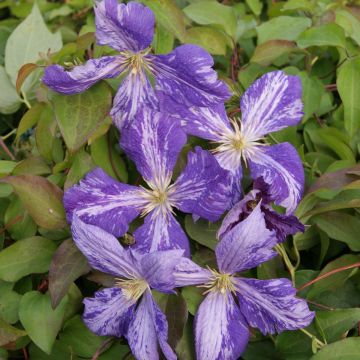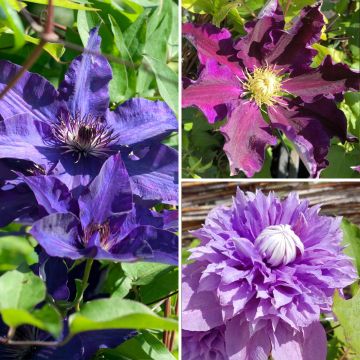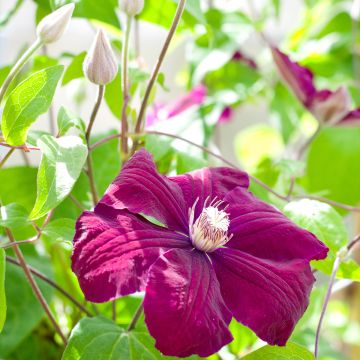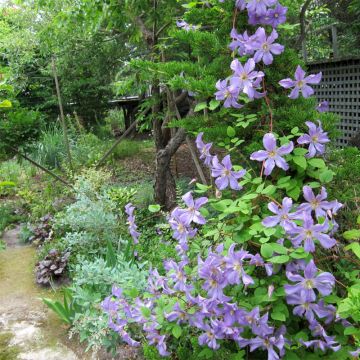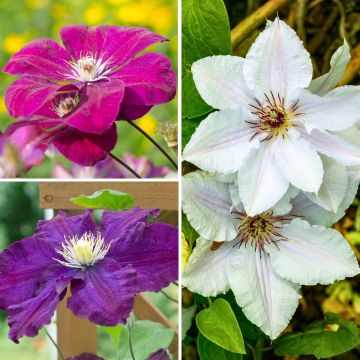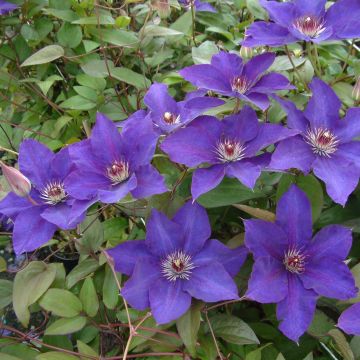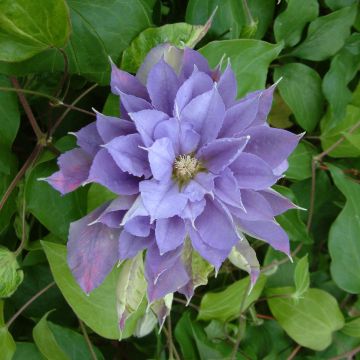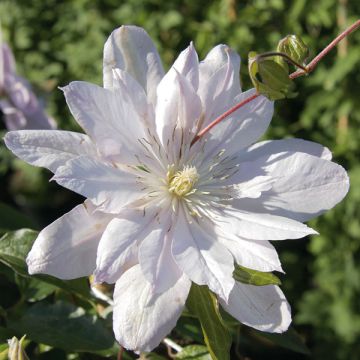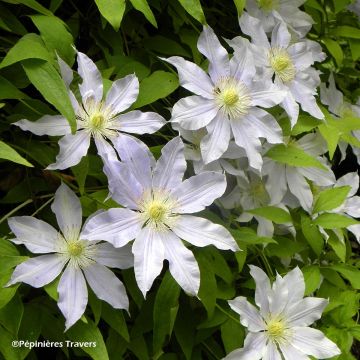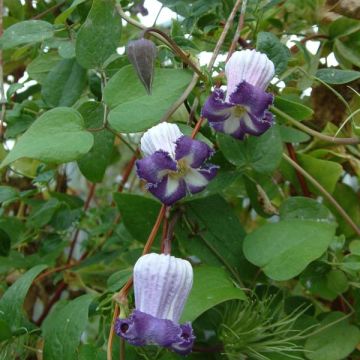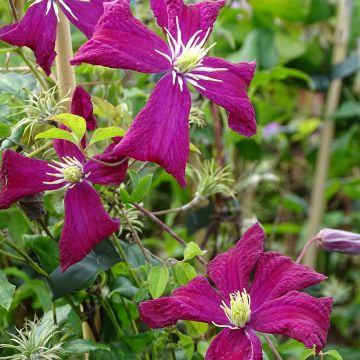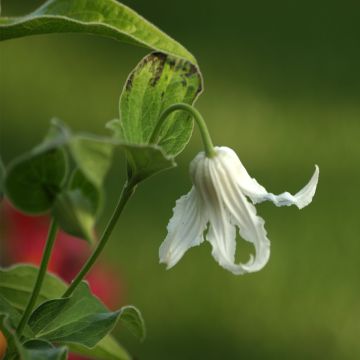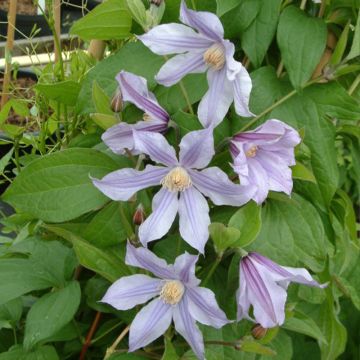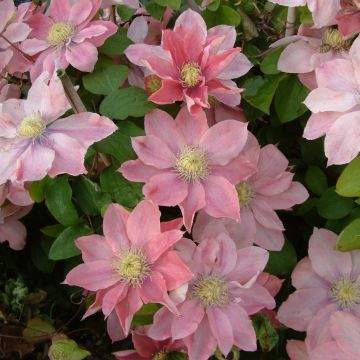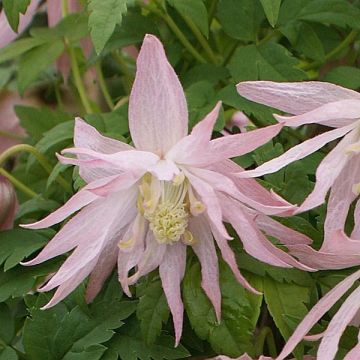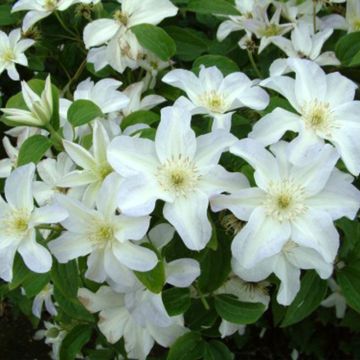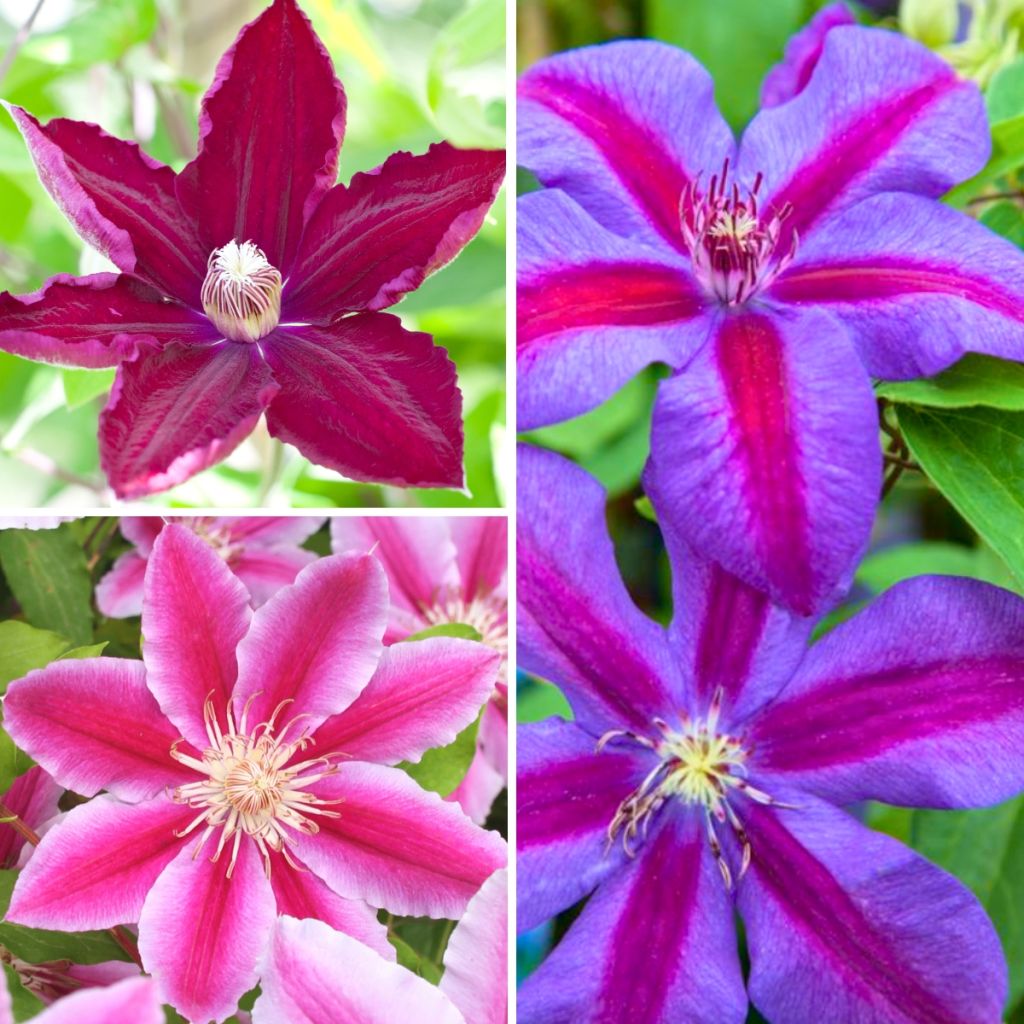

Clematis Red Mix - Rouge Cardinal, Mrs N. Thompson and Doctor Ruppel
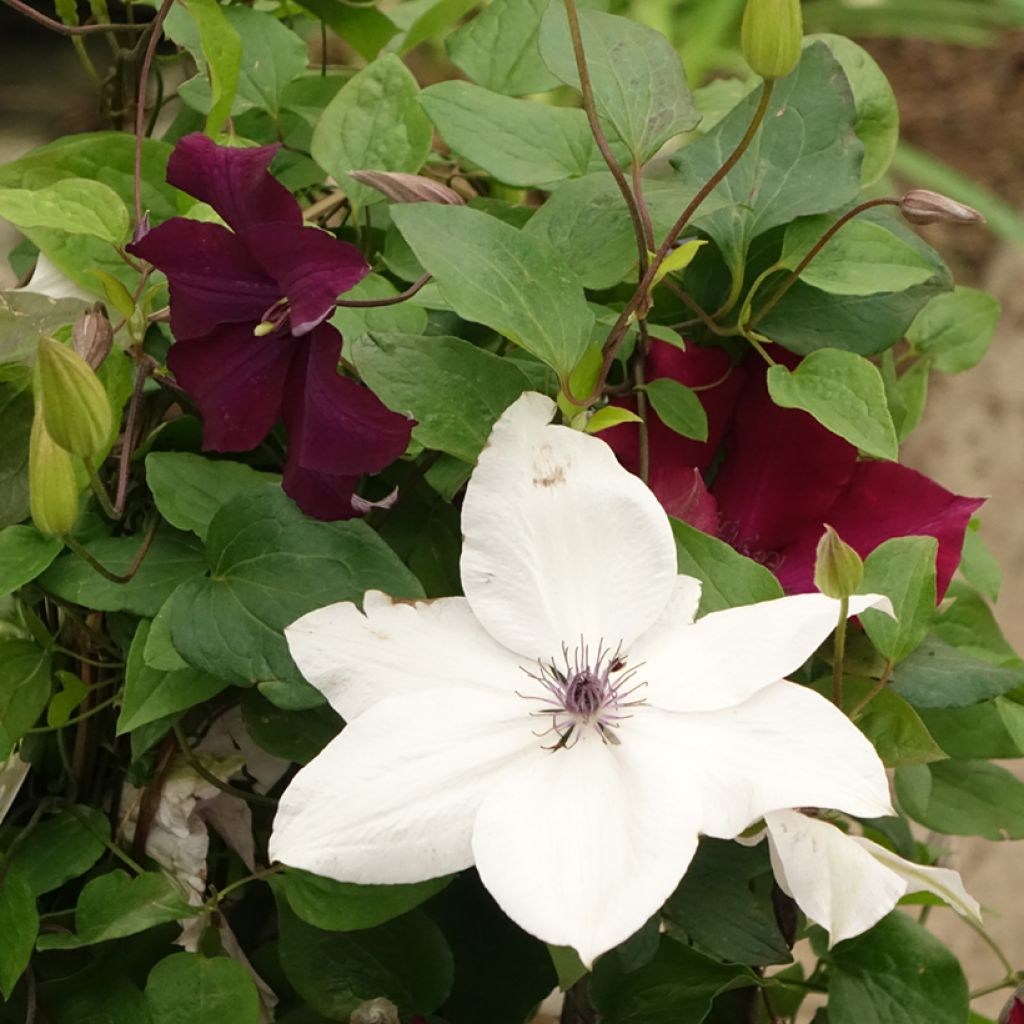

Clematis Red Mix - Rouge Cardinal, Mrs N. Thompson and Doctor Ruppel
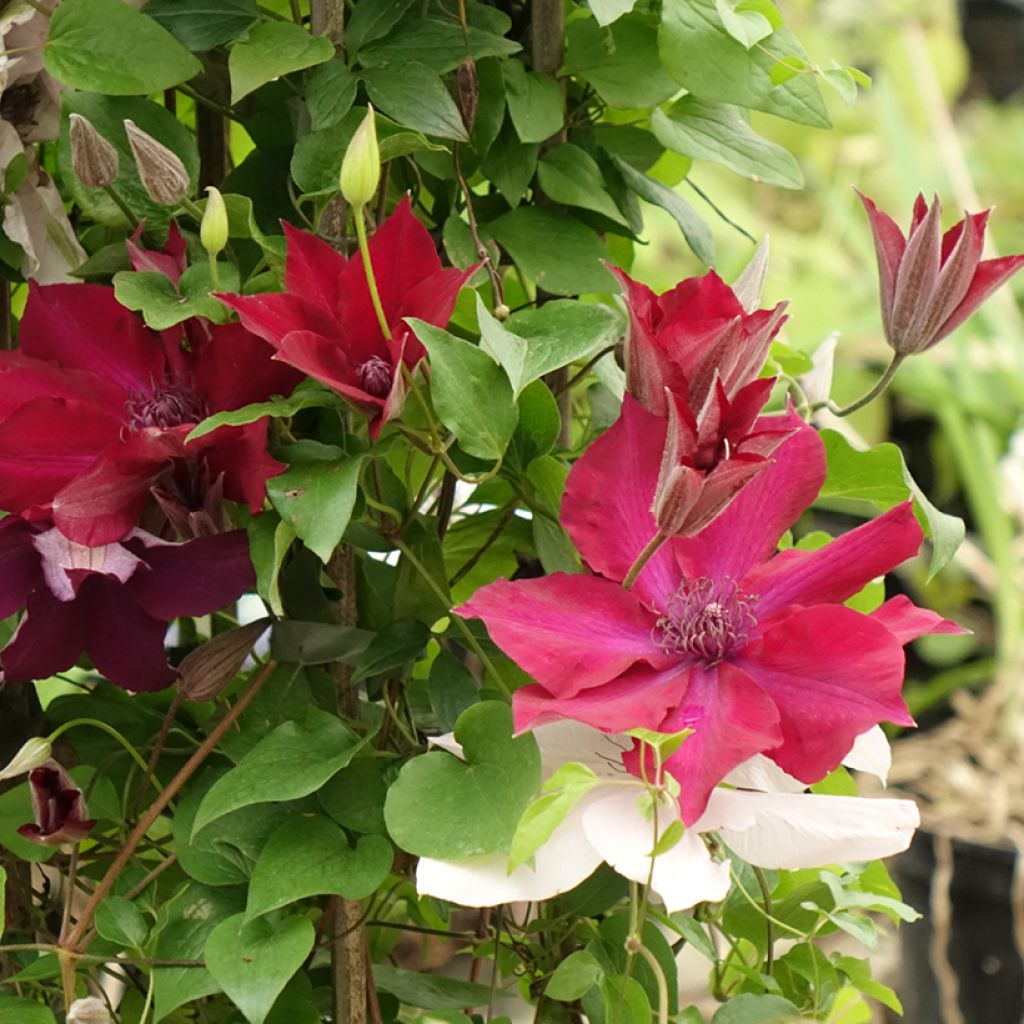

Clematis Red Mix - Rouge Cardinal, Mrs N. Thompson and Doctor Ruppel
Clematis Red Mix - Rouge Cardinal, Mrs N. Thompson and Doctor Ruppel
Clematis Mix Red
Traveller's Joy, Old Man's Beard, Virgin's Bower
This item cannot be shipped to the selected country
Delivery charge from €5.90
More information
Schedule delivery date,
and select date in basket
This plant carries a 6 months recovery warranty
More information
We guarantee the quality of our plants for a full growing cycle, and will replace at our expense any plant that fails to recover under normal climatic and planting conditions.
From €5.90 for pickup delivery and €6.90 for home delivery
Express home delivery from €8.90.
Does this plant fit my garden?
Set up your Plantfit profile →
Description
Clematis Three Sisters red trio combines three varieties of clematis in the same pot, each offering a range of colours based on red. 'Rouge Cardinal' is a French creation, opening up to a dark red that gradually lightens. 'Mrs N. Thompson' comes from England and produces bright purple flowers. 'Doctor Ruppel' originates from Argentina and blooms with beautiful, impressively large two-tone pink stars. They are compact varieties, reaching a height of 2m or 2.50m and make a superb flowering pot from May to September. They will be ideal for a sunny balcony or terrace and do not need protection during winter as all three plants are very hardy.
Clematis belongs to the family of Ranunculaceae, like columbines or anemones. They are found in Europe, the Himalayas, China, Australia and North and Central America. The genus includes more than 200 species, mostly climbing plants. They can be compact or capable of reaching heights of up to 8m in trees like the Clematis montana, but also a few non-climbing herbaceous plants, such as the Clematis heracleifolia.
The range of beautiful blooms is so vast that choosing between them can be difficult. This collection will delight you with 3 superb varieties in complementary warm colours. The variety 'Rouge Cardinal', created in 1968, has the famous 'Ville de Lyon' and 'Pourpre Mat' as its parents. This crossbreeding has resulted in a superb variety with dark red flowers measuring 10 to 12cm in diameter, enhanced by a beautiful crown of cream stamens with purple anthers. Flowering begins in June, with very dark red flowers like precious velvet, and ends in September-October with flowers that gradually lighten. The flowering is followed by decorative silvery grey feathery seed heads that persist until winter. The smooth leaves are divided into 3 elliptical to lanceolate, dark green leaflets. This clematis is relatively compact, reaching a height of 2.50m, up to a maximum of 3m if left unpruned.
The second plant in this composition, 'Mrs N. Thompson', is a relatively old English creation (1954) by breeder Walter Pennell, which has retained all its appeal. The main flowering period extends from May to June, with a second bloom in August-September. Beautiful star-shaped flowers, measuring 8 to 10cm in diameter, illuminate the foliage with their warm colours. The elongated tepals are swollen in the centre and are a beautiful violet hue on the periphery, quickly transitioning to a purple-red in the middle. The corolla's centre is made up of purple-red anthers and cream stamens. The deciduous foliage is light to medium green, which particularly enhances the flowers. This quite compact variety will reach a height of 2m, sometimes 2.50m if left unpruned.
'Doctor Ruppel', the third clematis, comes from much further away, as its breeder, who named it after himself, was born in Argentina before being introduced to Europe in the 1970s. It is very attractive with very large, single and occasionally semi-double flowers measuring 15cm in diameter. The long bright pink tepals in the middle lighten towards the periphery, making them appear even narrower than they are. While the flowers seem almost bicolour during the first bloom in May-June, the middle part of the tepals fades slightly during the second bloom in September. The cream-white heart of the stamens and anthers beautifully contrasts with the corolla, which is further enhanced by the dark green foliage. Pretty silvery and decorative feathery seed heads form at the end of the flowering period, further enhancing the interest of this variety.
These three clematis are very hardy (around -25°C) and love the sun, provided that their base is protected. A moist, humus-bearing soil is suitable for them, without excessive moisture, and this original composition will give you flowers throughout summer. A balcony or terrace is enough to enjoy their abundance.
This beautiful composition of generous climbers will enhance your terrace beautifully, creating an attractive scene that you can complement with other flowering plants. Buddleia Lilac Chip, a dwarf butterfly bush, will offer you lilac-blue spike flowers throughout the summer. Its spreading habit allows it to be grown in a pot for a long time, and its hardiness is similar to that of clematis. Another plant well suited for container gardening is the dwarf Indian lilac, such as the compact and dense variety Berry Dazzle. It is decorative from the appearance of its young bronze-tinted foliage and its summer flowering of pink-fuchsia is particularly abundant. Abelia Magic Daydream, with its semi-evergreen foliage variegated with white-cream and pink, and its bell-shaped white-pink fragrant flowers in summer, will also be a very good companion for your clematis.
Report an error about the product description
Clematis Red Mix - Rouge Cardinal, Mrs N. Thompson and Doctor Ruppel in pictures
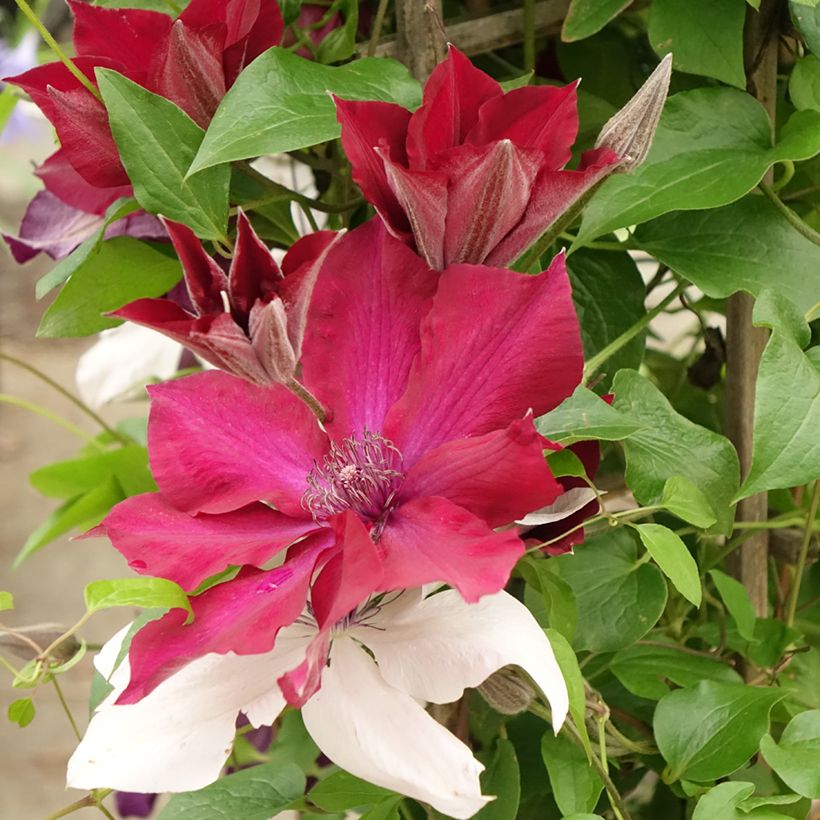

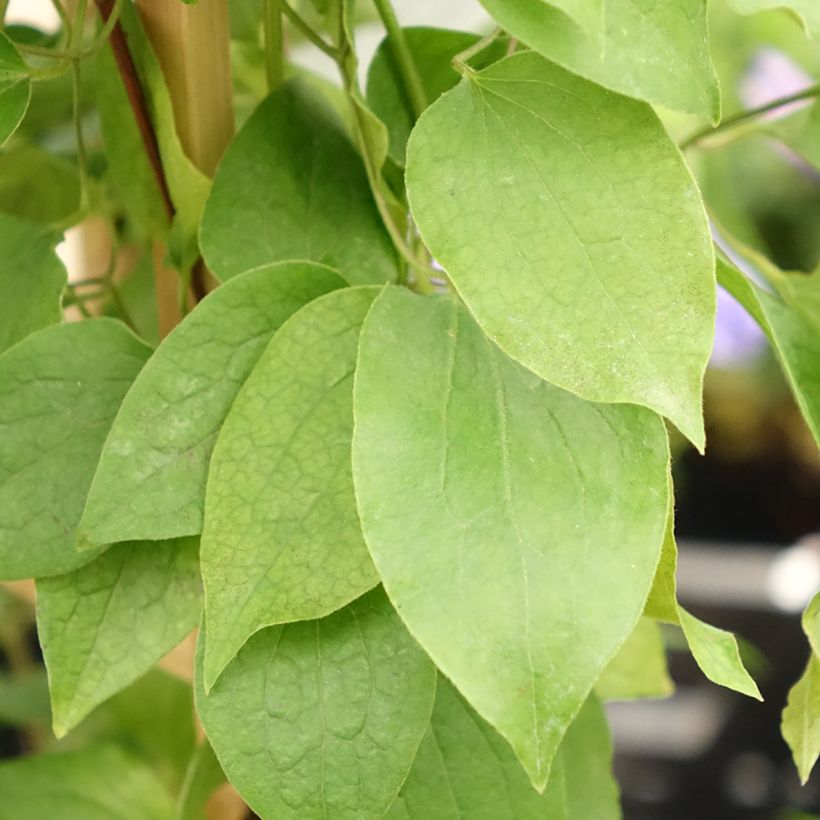

Plant habit
Flowering
Foliage
Safety measures
Botanical data
Clematis
Mix Red
Ranunculaceae
Traveller's Joy, Old Man's Beard, Virgin's Bower
Cultivar or hybrid
atteintescutaneomuqueuses
Cette plante peut provoquer l'apparition de réactions cutanées indésirables, une atteinte des yeux, ou des difficultés respiratoires si elle est ingérée.
Ne la plantez pas là où de jeunes enfants peuvent évoluer. Evitez tout contact avec la peau: privilégiez l'emploi de gants pour la manipuler. En cas de contact, lavez-vous soigneusement les mains et rincez abondamment à l'eau la zone concernée. Lavez les vêtements entrés en contact. En cas de réaction cutanée, contactez votre médecin ou le centre antipoison le plus proche de chez vous. En cas d'atteinte étendue ou de difficultés respiratoires, appelez immédiatement le 15 ou le 112.Pensez à conserver l'étiquette de la plante, à la photographier ou à noter son nom, afin de faciliter le travail des professionnels de santé.
Davantage d'informations sur https://plantes-risque.info
Other Clematis Jackmanii
Planting and care
This composition of clematis is intended to stay in a pot to enhance a terrace. After about 2 years, it will be a good idea to repot it in a larger pot or container, to allow the roots to develop well. Choose a pot that is deeper than wide so that it is suitable for the root system of these plants.
However, if you wish to plant your clematis in the garden, these plants like to have their heads in the sun and their feet in the shade. Plant them in fertile, humus-rich, well-drained soil, shading the roots and the base of the stem with a flat tile, for example. Be careful as clematis can wither in overly wet soil. After planting, cut back the stems of the clematis to approximately 30 cm from the base, above a nice pair of buds. During the first few weeks, water regularly. However, be careful not to let the water stagnate, as this can cause a fungus to develop at the collar. Mulch all clematis in February with garden compost or well-rotted manure, avoiding direct contact with the stems. Train the stems, without crushing them, until the plants cling to them themselves. Clematis also like to grow freely on neighbouring plants.
Slugs can attack clematis and devour the stems. Aphids and greenhouse whiteflies are also potential parasites of clematis.
Avoid fertilisers that are high in nitrogen, as they would favour foliage at the expense of flowering. Instead, choose an organic fertiliser that is more concentrated in potash (the K in the N-P-K formula) than in nitrogen (the N).
Planting period
Intended location
Care
This item has not been reviewed yet - be the first to leave a review about it.
Clematis
Haven't found what you were looking for?
Hardiness is the lowest winter temperature a plant can endure without suffering serious damage or even dying. However, hardiness is affected by location (a sheltered area, such as a patio), protection (winter cover) and soil type (hardiness is improved by well-drained soil).

Photo Sharing Terms & Conditions
In order to encourage gardeners to interact and share their experiences, Promesse de fleurs offers various media enabling content to be uploaded onto its Site - in particular via the ‘Photo sharing’ module.
The User agrees to refrain from:
- Posting any content that is illegal, prejudicial, insulting, racist, inciteful to hatred, revisionist, contrary to public decency, that infringes on privacy or on the privacy rights of third parties, in particular the publicity rights of persons and goods, intellectual property rights, or the right to privacy.
- Submitting content on behalf of a third party;
- Impersonate the identity of a third party and/or publish any personal information about a third party;
In general, the User undertakes to refrain from any unethical behaviour.
All Content (in particular text, comments, files, images, photos, videos, creative works, etc.), which may be subject to property or intellectual property rights, image or other private rights, shall remain the property of the User, subject to the limited rights granted by the terms of the licence granted by Promesse de fleurs as stated below. Users are at liberty to publish or not to publish such Content on the Site, notably via the ‘Photo Sharing’ facility, and accept that this Content shall be made public and freely accessible, notably on the Internet.
Users further acknowledge, undertake to have ,and guarantee that they hold all necessary rights and permissions to publish such material on the Site, in particular with regard to the legislation in force pertaining to any privacy, property, intellectual property, image, or contractual rights, or rights of any other nature. By publishing such Content on the Site, Users acknowledge accepting full liability as publishers of the Content within the meaning of the law, and grant Promesse de fleurs, free of charge, an inclusive, worldwide licence for the said Content for the entire duration of its publication, including all reproduction, representation, up/downloading, displaying, performing, transmission, and storage rights.
Users also grant permission for their name to be linked to the Content and accept that this link may not always be made available.
By engaging in posting material, Users consent to their Content becoming automatically accessible on the Internet, in particular on other sites and/or blogs and/or web pages of the Promesse de fleurs site, including in particular social pages and the Promesse de fleurs catalogue.
Users may secure the removal of entrusted content free of charge by issuing a simple request via our contact form.
The flowering period indicated on our website applies to countries and regions located in USDA zone 8 (France, the United Kingdom, Ireland, the Netherlands, etc.)
It will vary according to where you live:
- In zones 9 to 10 (Italy, Spain, Greece, etc.), flowering will occur about 2 to 4 weeks earlier.
- In zones 6 to 7 (Germany, Poland, Slovenia, and lower mountainous regions), flowering will be delayed by 2 to 3 weeks.
- In zone 5 (Central Europe, Scandinavia), blooming will be delayed by 3 to 5 weeks.
In temperate climates, pruning of spring-flowering shrubs (forsythia, spireas, etc.) should be done just after flowering.
Pruning of summer-flowering shrubs (Indian Lilac, Perovskia, etc.) can be done in winter or spring.
In cold regions as well as with frost-sensitive plants, avoid pruning too early when severe frosts may still occur.
The planting period indicated on our website applies to countries and regions located in USDA zone 8 (France, United Kingdom, Ireland, Netherlands).
It will vary according to where you live:
- In Mediterranean zones (Marseille, Madrid, Milan, etc.), autumn and winter are the best planting periods.
- In continental zones (Strasbourg, Munich, Vienna, etc.), delay planting by 2 to 3 weeks in spring and bring it forward by 2 to 4 weeks in autumn.
- In mountainous regions (the Alps, Pyrenees, Carpathians, etc.), it is best to plant in late spring (May-June) or late summer (August-September).
The harvesting period indicated on our website applies to countries and regions in USDA zone 8 (France, England, Ireland, the Netherlands).
In colder areas (Scandinavia, Poland, Austria...) fruit and vegetable harvests are likely to be delayed by 3-4 weeks.
In warmer areas (Italy, Spain, Greece, etc.), harvesting will probably take place earlier, depending on weather conditions.
The sowing periods indicated on our website apply to countries and regions within USDA Zone 8 (France, UK, Ireland, Netherlands).
In colder areas (Scandinavia, Poland, Austria...), delay any outdoor sowing by 3-4 weeks, or sow under glass.
In warmer climes (Italy, Spain, Greece, etc.), bring outdoor sowing forward by a few weeks.


































